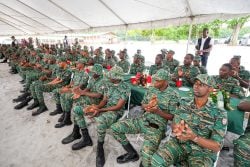By Joseph Allen
The Ministry of Foreign Affairs and International Cooperation is closing in on its development of a framework that not only addresses the sourcing of labour but also skill specialization and certification. It is estimated that Guyana currently has a labour shortage of 100,000 people.
At another of its Multi-Stakeholders Meetings on Guyana’s Labour Needs hosted by the Diaspora Unit of the Ministry of Foreign Affairs and International Cooperation, Foreign Secretary, Robert Persaud, yesterday provided the estimate of 100,000 people.
“It was assessed that we need in terms of skills and persons for the various industries and sectors that are expanding close to 100,000 more persons,” Persaud said. He explained that this figure came out while in conversation with key stakeholders.
“It wasn’t a survey done, it was an average or an estimate. So, it’s not based on [empirical data] but rather based on data projections from various sectors. It’s based on what has happened in the country in the last year and it’s based on what is needed going forward”, he said.

Persaud identified the construction and oil and gas sectors as the ones with the highest labour demand.
“A lot of this comes from the construction sector, the new sectors that have been growing, some of the planned projects, all of this is taken into account; some of the mega projects that are coming on board (the road construction projects, hotels, bridges, some of the things that are being expanded) projects that will cater for the expanding sectors of the economy,” Persaud said when Stabroek News contacted him for clarification.
It was noted that while there is a [labour] shortage, work also has to be done on where this labour will be placed.
“It is what you call mobility labour, where you have excess labour supply in one region, you move them into the area where they are needed, all of that is targeted. So, it includes areas of underemployment, or where persons are not fully employed. So, take for instance, let’s say in Region 9, Region 2, Region 10, you know, those areas you may find that you do not have labour and [you] take that workforce into the area where they are needed.”
Persaud said what needs to be done next is to determine the level of foreign input in the human resources bank while ensuring that Guyanese in the global diaspora are given opportunities. The continuing conversation surrounding the labour shortage and its demand comes a few weeks after Minister of Public Works, Juan Edghill, who was speaking to a previous Multi-Stakeholders Meeting on Guyana’s Labour needs, dropped a bombshell when he informed the audience that Government had to resort to the importation of labour down to the level of drivers. At that meeting, Edghill pointed out that he had no choice but to grant work permits to foreign truck drivers to work on the Ogle – Eccles Road.
The stakeholders’ engagement were driven by the need to fill the labour gap in Guyana, and to address the challenge of finding Diaspora Guyanese who are willing to return home and enter into the local workforce. And while consulting on how to address that challenge, the Foreign Secretary found that companies and agencies also had a problem of finding suitable overseas candidates. A meeting to try and find a solution to the problems among different stakeholders was called and it was found that the issue should be addressed via countrywide consultations with a structured plan on how to resolve the labour issue as the final objective. As such, Persaud has, over the past months, held talks with agencies, companies, and others at finding solutions and to build a framework to ensure that there is a plan to fall back on if the need arises. The Multi-Stakeholders Meeting on Guyana’s Labour Needs yesterday is one of those fora and Persaud noted that they are getting closer to that framework.
Head of the Diaspora Unit, Rosalinda Rasul addressed the issue of the framework or plan when she said at the forum “…what we want to do now is bring key stakeholders. So, we are going to narrow it down to a smaller group where we are going to draft or link a framework for tackling some of the issues; using all the agencies, the private sector, the chamber of commerce, and the private sector, for example, or using their support bases really to address the shortages in the country.”
Rasul said one of the problems that will be addressed is matching persons to job specifications. “One of the key things that came out here is actually matching a person looking for jobs and do not know where to find it and that also factors in training. So, a lot of the agencies that are involved in training, for example, the Board of Industrial Training, TVET and so on. You know even the University of Guyana who is doing programmes that are needed said that if they get more information in terms of projection for companies and industries on the sectors as to where they want to go in the next three or four or five years from now, that they will be more able to plan and train persons who are looking for jobs to be able to secure that job.”
“Another key thing that came out of the meeting, we find, is that a lot of the support is already in existence but the problem is a lack of coordination. So, they are not able to benefit from each other. So, for example, there was a private sector company wanting to know how we can get a lot of our technical persons coming for jobs, they are very skilled and very experienced but they lacked certification but then we learnt from the Board of Industrial Training that they have a programme where they can actually assess them and provide that certification but they (the company) did not know that, so a forum like this can bring all the stakeholders together where they can share information and benefit from each other,” Rasul added.
Images stored in Joseph Allen images as ‘Multi-Stakeholders Meeting on Guyana’s Labour Needs’





